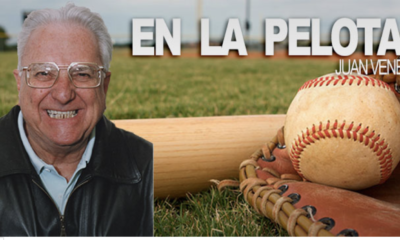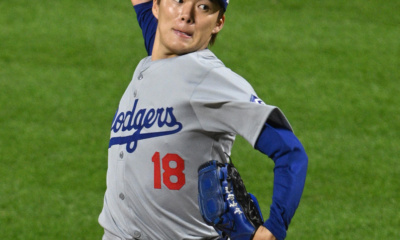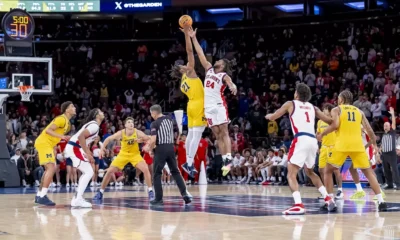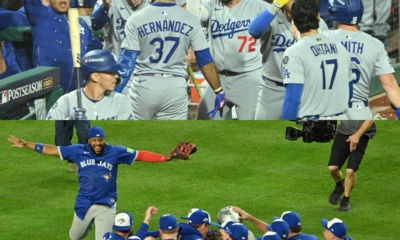
Soldiers in the Hall of Fame, Including Bob Feller, Yogi Berra, and 62 Others
Coral Gables, Florida (VIP-WIRE) – There is peace between Israel and Gaza. It is hoped, and prayed, that there will soon be peace between Russia and Ukraine.
The American Wars have been directly linked to baseball, because 64 of its most notable figures were valuable soldiers on the front lines of those conflicts.
These 64 are the ones who were eligible for induction into Cooperstown. But the total number of professional baseball players in the American Wars has been in the thousands.
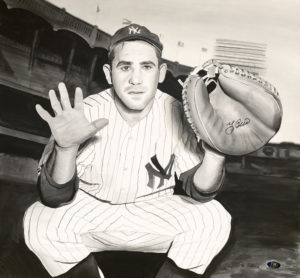
Yogi Berra was 19 years old playing in the Minor Leagues (Triple A), when he was called to serve in World War II.
The most famous of the minors was a certain Lawrence Berra, then 19 years old, who was struggling in Triple-A, trying to make it to the Yankees, when he was called up. and he had to participate in D-Day, or the invasion of Normandy.
Like 160,000 other soldiers, this man, who later became Yogi in the Major Leagues, had to walk through water up to his neck and carrying war material on his head for more than 500 meters until he reached dry land.
Bob Feller Left Baseball for WWII
When Bob Feller, a 23-year-old pitcher for the Cleveland Indians, volunteered for World War II on Tuesday, December 9, 1941, it had been 50 hours since the United States had been unexpectedly attacked by the Japanese at its Pearl Harbor Naval Base, west of Honolulu, Hawaii. It had been 24 hours since the Union had declared war, which had broken out two years earlier.
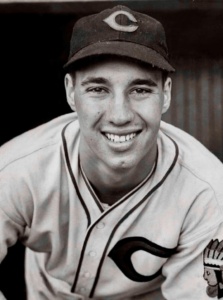
Bob Feller left MLB to enlist in the Navy after the attack on Pearl Harbor by Japan.
Japan used 353 planes for that attack, destroying 188 American planes and dozens of ships, in addition to killing 2,403 people and wounding 1,178.
Feller said, “I can’t play baseball while my homeland is being attacked like this.”
In his three previous seasons, 1939, 1940, and 1941, he had a record of 24-9, 2.85; 27-11, 2.61; and 25-13, 3.15. He threw a fastball at speeds of up to 107.6 miles per hour (173.2 kilometers per hour).
After the war, he returned in 1942, laden with decorations. And Captain Feller completed 18 seasons in the Major Leagues, with 266 wins, 162 losses, and a 3.25 ERA.
When he returned from the war and was called a hero, he warned, “I’m no hero… Heroes don’t come back.”
Feller was inducted into the Cooperstown Hall of Fame in 1962, with 150 out of 160 votes.
He died in Cleveland, at the age of 92, of leukemia, on December 15, 2010. He was the first professional athlete to enlist in World War II.
Since World War I
The first baseball player to be inducted into Cooperstown after serving in a war was Morgan Bulkeley, team owner and the first President of the National League, in 1876. Inducted into the HOF in 1937, he died in 1922.
Baseball’s 64 HOF Warriors
The 64 soldiers from the wars who were later inducted into the Cooperstown Hall of Fame. In addition to the big leaguers, there are also Negro League players, executives, and umpires.
Civil War, 1861–1885: Morgan Bulkeley.
World War I, 1914–1918: Grover Cleveland Alexander, Happy Chandler, Oscar Charleston, Ty Cobb, Eddie Collins, Jocko Colan, Red Farber, Warren Giles, Burleigh Grimes, Harry Heilmann, Waite Hoyt, George Kelly, Harry MacPhail, Rabbit Maranville, Rube Marquard, Christy Mathewson, Herb Pennock, Sam Rice, Branch Rickey, Eppa Rixey, Bullet Joe Rogan, Joe Sewell, George Sisler, Tris Speaker, Casey Stengel.
World War II, 1939-1945: Luke Appling, Al Barlick, Yogi Berra, Nestor Chylak, Mickey Cochrane, Leon Day, Bill Dickey, Joe DiMaggio, Larry Dobby, Bobby Doerr, Bob Feller, Charlie Gehringer, Hank Greenberg, Billy Herman, Mone Irvin, Raph Kiner, Bob Lemon, Ted Lyons, Larry MacPhail, Lee MacPhail, Johnny Mize, Stan Musial, Pee Wee Reese, Phil Rizzuto, Robin Roberts, Jakie Robinson, Red Ruffing, Red Schoendienst, Enos Slaughter, Duke Snider, Warren Spahn, William ‘Bill’ Veeck, Hoyt Wilhelm, Ted Williams, Early Wynn.
Korean War, 1950-1953: Ernie Banks, Whitey Ford, Eddie Mathews, Willie May, Ted Williams.
Note: Ted Williams and Larry MacPhail were in two wars each.
Thanks to life, which has given me so much, even a reader like you.
@juanvene
TREMENDO ESTACIONAMIENTO
RESTAURANT CASTIZO Y VINOS
EN PLENA AVENIDA 27
1673 SW 27th Ave.
MIAMI FL, 33145
TEL: (305) 640-5658
USTED COME BIEN
EN SU CASA
Y AQUI
(En Español)
Los Peloteros en las Guerras de USA
Soldados en el Hall de la Fama; Bob Feller, Yogi Berra y Otros 62
Coral Gables, Florida (VIP-WIRE) – Hay paz entre Israel y Gaza. Se espera, y se reza, para que pronto la haya entre Rusia y Ucrania.
Las Guerras de Estados Unidos han estado vinculadas directamente con el beisbol, porque 64 de sus más notables personajes fueron valiosos soldados en los frentes de esas contiendas.
Estos 64 son los que tuvieron con qué ser exaltados a Cooperstown. Pero el total de peloteros profesionales en Guerras de Estados Unidos, ha sido de millares.
El más famoso de las menores fue un tal Lawrence Berra, entonces de 19 años, quien luchaba en Triple A, tratando de llegar a los Yankees, cuando fue llamado al frente; y le tocó participar en el D-Day o invasión de Normandía.
Como otros 160 mil efectivos, ese, quien después fue Yogi en Grandes Ligas, tuvo que caminar con el agua al cuello y cargado sobre la cabeza, con el material de guerra, durante más de 500 metros, hasta llegar a tierra firme.
Bob Feller Deja el Beisbol Por la Guerra
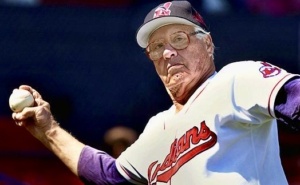
Bob Feller, haciendo un lanzamiento de honor en Cleveland, dejó el beisbol en 1941 para irse de voluntario a la 2da Guerra Mundial.
Cuando Bob Feller, lanzador de los Indios de Cleveland, de 23 años de edad, se presentó como voluntario para la II Guerra Mundial, el martes nueve de diciembre de 1941, hacía 50 horas que Estados Unidos había sido atacado sorpresivamente por los japoneses, en su Base Naval de Pearl Harbor, al oeste de Honolulú, en Hawai. Y hacía 24 horas que la Unión se había declarado en la Guerra, que había estallado hacía dos años.
Japón utilizó 353 aviones para ese ataque y destruyeron 188 de Estados Unidos, igual que docenas de barcos, además de matar a 2,403 personas y herir a 1,178.
Feller dijo: “No puedo jugar beisbol, mientras mi patria es atacada en esta forma”.
En sus tres campañas anteriores, 1939, 1940 y 1941, había dejado récord de 24-9, 2.85; 27-11, 2.61; y 25-13, 3.15. Tiraba la recta hasta a 107.6 millas por hora, 173.2 kilómetros por hora.
Al terminar la guerra, regresó, en 1942, cargado de condecoraciones. Y el Capitán Feller completó 18 temporadas en Grandes Ligas, con 266 victorias, 162 derrotas y efectividad de 3.25.
Cuando al volver de la guerra lo llamaron héroe, advirtió: “No soy héroe… Los héroes no regresan”.
Feller fue elevado al Hall de la Fama de Cooperstown, en 1962, con 150 votos de 160.
Murió en Cleveland, a los 92 años de edad, de leucemia, el 15 de diciembre de 2010. Fue el primer atleta profesional alistado en la II Guerra Mundial.
Desde la Primera Guerra Mundial
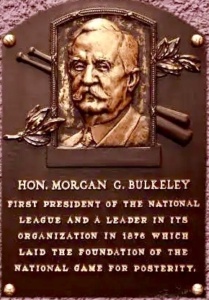
Morgan G. Bulkeley, fue el primer presidente de la Liga Nacional y el primer soldado en ser elevado al Hall de la Fama.
El primero del beisbol que, después de participar en una Guerra, fue elevado a Cooperstown, fue Morgan Bulkeley, propietario de equipo y el primer Presidente de la Liga Nacional, en 1876. Exaltado al HOF en 1937, había muerto en 1922.
Los 64 Guerreros del Beisbol
Los 64 militares de las Guerras, que después fueron elevados al Hall de la Fama de Cooperstown. Además de los big leaguers, también hay jugadores de las Ligas Negras, ejecutivos y umpires.
Guerra Civil, 1861-1885: Morgan Bulkeley.
Primera Guerra Mundial, 1914-1918: Grover Cleveland Alexander, Happy Chandler, Oscar Charleston, Ty Cobb, Eddie Collins, Jocko Colan, Red Farber, Waren Giles, Burleigh Grimes, Harry Heilmann, Waite Hoyt, George Kelly, Harry MacPhail, Rabbit Maranville, Rube Marquard, Christy Mathewson, Herb Pennock, Sam Rice, Branch Rickey, Eppa Rixey, Bullet Joe Rogan, Joe Sewell, George Sisler, Tris Speaker, Casey Stengel.
Segunda Guerra Mundial, 1939-1945: Luke Appling, Al Barlick, Yogi Berra, Nestor Chylak, Mickey Cochrane, Leon Day, Bill Dickey, Joe DiMaggio, Larry Dobby, Bobby Doerr, Bob Feller, Charlie Gehringer, Hank Greenberg, Billy Herman, Mone Irvin, Ralph Kiner, Bob Lemon, Ted Lyons, Larry MacPhail, Lee MacPhail, Johnny Mize, Stan Musial, Pee Wee Reese, Phil Rizzuto, Robin Roberts, Jakie Robinson, Red Ruffing, Red Schoendienst, Enos Slaughter, Duke Snider, Warren Spahn, William ‘Bill’ Veeck, Hoyt Wilhelm, Ted Williams, Early Wynn.
Guerra de Korea,1950-1953: Ernie Banks, Whitey Ford, Eddie Mathews, Willie May, Ted Williams.
Nota: Ted Williams y Larry MacPhail estuvieron en dos guerras cada uno.
Gracias a la vida que me ha dado tanto, incluso un lector como tú.
@juanvene






